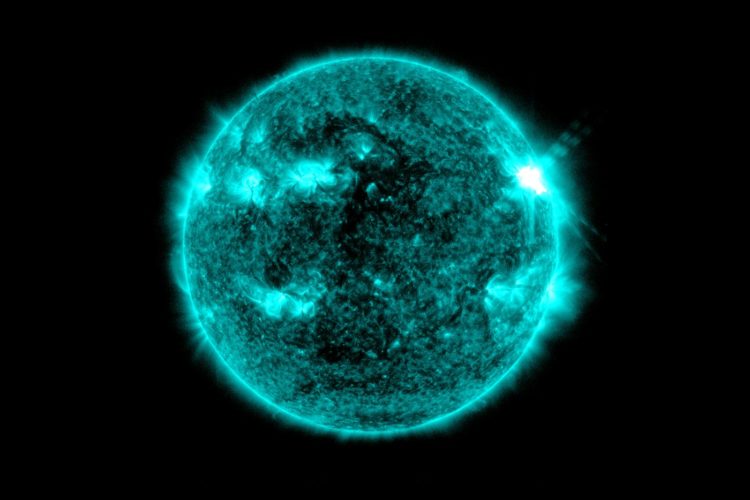What is a solar flare?
You might have heard about solar flares on in the news periodically — how they can cause bad things to happen, and we might all end up back in the stone age.
So what is a solar flare, do they really cause problems here on Earth — and should you worry?
What is a solar flare — and is it going to cause huge power outages and fry your GPS. The mainstream media has been full of worrisome headlines… but is this really a big deal?
Flared up
Whenever the sun continues to climb towards the peak of the 11-year solar cycle , we hear more and more about solar flares — and the havoc that they can possibly wreak on our modern, technologically-based society. So what’s the deal?
Solar indigestion
Solar flares occur when accelerated charged particles — usually electrons — interact with the sun’s plasma surface. The sun’s enormous magnetic field essentially acts as a particle accelerator (much like the Large Hadron Collider, or more colloquially, an “atom smasher”).
When the accelerated particles hit the sun’s plasma medium, all heck breaks loose and massive amounts of energy is emitted, essentially in the form of X-rays — though the energy is also emitted in visual light and radio waves, as well. That’s a solar flare.
If you’re curious, solar flares are classified according to the peak flux in watts per square meter as A, B, C, M, or X — from weakest to strongest. For the most part, anything below an X class flare doesn’t generally warrant worrying about.
Electrical heartburn
So… what does that mean for us here on Earth?
Well, when that radiation happens to cross paths with us, and makes contact with the our planet’s upper atmosphere, a whole host of things can happen.
First of all, the Northern and Southern lights will generally make their way further south (or north, for those of you in the antipodes) than they are normally visible. They’re pretty spectacular, but in and of themselves, harmless.
However, while we’re all enjoying a pretty light show, other not so pleasant things may be occurring. As that massive burst of energy hits, it creates something called a geomagnetic storm.

Geomagnetic storms are capable of disrupting long-distance, radio-based communication — such as air-to-ground, ship-to-shore, shortwave broadcast, and amateur radio — as frequencies below 30 MHz become disrupted, or in cases of severe storms, completely useless.
Not the end of the world, for shortwave enthusiasts or ham radio folks… they just chill out till things are back to normal. However, it’s slightly more of a problem when the airliner you are on is having trouble talking to the tower.
Navigation systems such as GPS and LORAN are often disrupted after very large flares as well. The distortions in the ionosphere can cause the signals these systems use to be degraded or lost entirely.
Of course, they can also take out the GPS system in another way. Satellites in orbit around the Earth don’t have as much protection from the energy of a solar flare, and when truly massive ones strike it’s not uncommon for satellites to perform erroneously or, once in a great while, fail entirely.
GPS, of course, uses a series of satellites in orbit to work. This can also cause disruption to long-distance telephone service, television, and internet — all of which can rely on satellites.
Finally, a truly powerful storm can actually contain enough energy to cause power blackouts — like in Quebec in 1989, or damage telephone lines. In fact, on September 1-2 of 1859, the largest solar flare in recorded history actually contained enough energy that the telegraph wires conducted it, in some cases shocking the telegraph operators — and even spontaneously combusting the telegraph paper.
The good news
Now that you’re all roiled up and in a froth and furiously stocking your cellar for the solar flare apocalypse of 2023ish — relax.
Truly massive flares, on the order of the 1859 one, are exceedingly rare. Even ones in the range of the 1989 flare aren’t exactly common.
For more comfort, consider this: In addition to the sun’s 11-year cycle, it seems the intensities of the solar cycles themselves wax and wane over the centuries.
The “modern maximum” occurred during solar cycle 19, peaking between 1958 and 1961. Since then each cycle has gotten a bit less intense (on average), culminating in the current cycle 24 — which appears to be a bit of a bust, from a solar activity standpoint.
So really, the bottom line is this: as a more technically-oriented and tech-dependent society, yes — a truly massive solar flare could really do some damage to our communication and power infrastructure.
However, truly massive solar flares are quite rare — despite what the media says. Although they are in the business of reporting the news, they’re also in the business of selling their services, and fear-mongering seems to be a rather effective way of doing so.
So, relax, don’t worry about skipping your flight, and enjoy the light show — hopefully, you’re far enough north to enjoy it.







